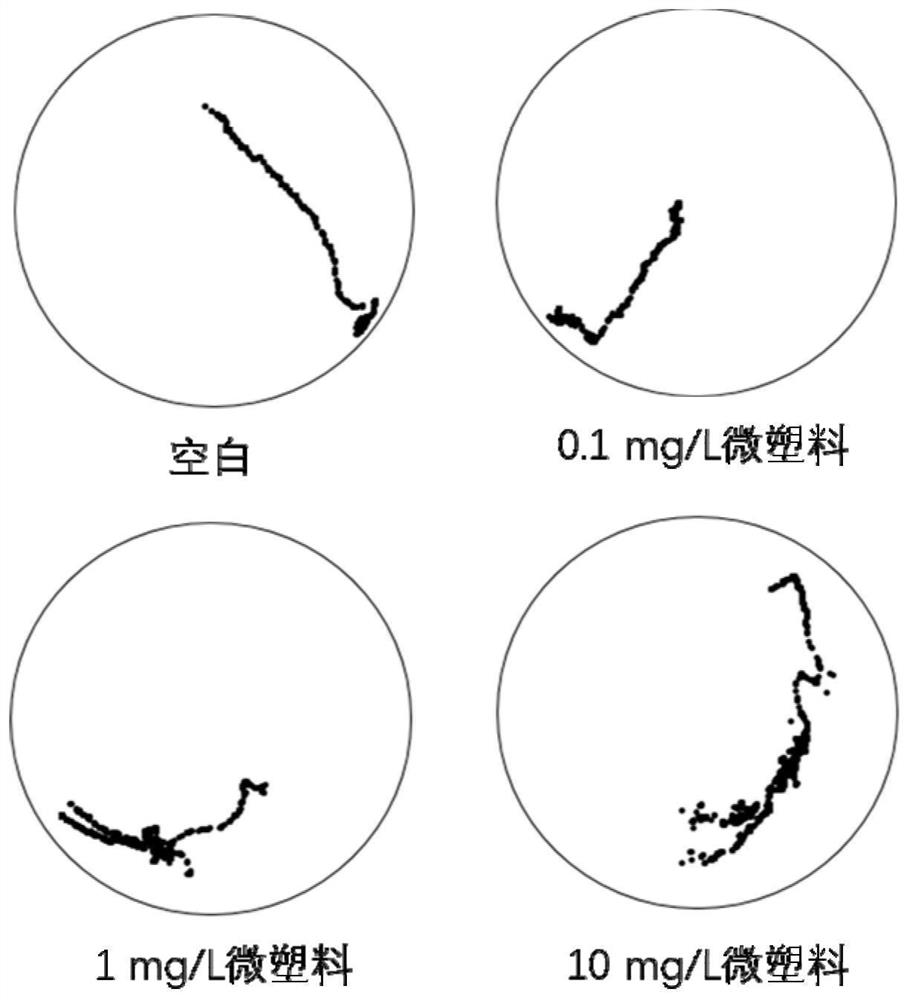Method for evaluating microplastic toxicity based on daphnia magna behavioral indexes
A technology of large daphnia and microplastics, applied in scientific instruments, analytical materials, material inspection products, etc., can solve the problems of inability to achieve rapid evaluation, strict experimental conditions, long experimental cycle, etc., and achieve strong practicability, low cost, and easy operation easy effect
- Summary
- Abstract
- Description
- Claims
- Application Information
AI Technical Summary
Problems solved by technology
Method used
Image
Examples
Embodiment 1
[0032] Comparing the biological toxicity of polystyrene microplastics with different particle sizes based on the behavioral indicators of Daphnia magna:
[0033] (1) The selected Daphnia magna had been cultivated continuously for one year under laboratory conditions. Specifically, Daphnia magna was cultured in reconstituted water configured with ultrapure water, and every 1000 mL of reconstituted water contained 58.5 mg of CaCl 2 2H 2 O, 24.7mg MgSO 4 ·7H 2 O, 13.0mg NaHCO 3 and 1.2mg KCl, and aerated for 24 hours before culturing; cultivate Daphnia magna in a light incubator, set the temperature at 22±1°C, and have a light-dark ratio of 16h:8h. Daphnia magna was fed with Scenedesmus obliques every day, and the feeding density was 10 5 cells / mL; Healthy adult Daphnia magna individuals from the same female line, 3 generations of parthenogenesis, and 7 days of age were selected for the exposure test.
[0034] (2) The aqueous suspensions of standard polystyrene microplastic...
Embodiment 2
[0041] The biological toxicity of different concentrations of polystyrene microplastics was compared based on the behavioral indicators of Daphnia magna:
[0042] (1) The selected Daphnia magna had been cultivated continuously for one year under laboratory conditions. Specifically, Daphnia magna was cultured in reconstituted water configured with ultrapure water, and every 1000 mL of reconstituted water contained 58.5 mg of CaCl 2 2H 2 O, 24.7mg MgSO 4 ·7H 2 O, 13.0mg NaHCO 3 and 1.2mg KCl, and aerated for 24 hours before cultivation; cultivate Daphnia magna in a light incubator, set the temperature at 25±1°C, and the light-dark ratio 12h:12h. During the cultivation period, the reconstituted water was changed 3 times a week. Daphnia magna was fed with Scenedesmus obliques every day, and the feeding density was 10 5cells / mL; Healthy adult Daphnia magna individuals from the same female line, 3 generations of parthenogenetic reproduction, and 10 days old were selected for th...
PUM
| Property | Measurement | Unit |
|---|---|---|
| dissolved oxygen | aaaaa | aaaaa |
| hardness | aaaaa | aaaaa |
| size | aaaaa | aaaaa |
Abstract
Description
Claims
Application Information
 Login to View More
Login to View More - R&D Engineer
- R&D Manager
- IP Professional
- Industry Leading Data Capabilities
- Powerful AI technology
- Patent DNA Extraction
Browse by: Latest US Patents, China's latest patents, Technical Efficacy Thesaurus, Application Domain, Technology Topic, Popular Technical Reports.
© 2024 PatSnap. All rights reserved.Legal|Privacy policy|Modern Slavery Act Transparency Statement|Sitemap|About US| Contact US: help@patsnap.com










